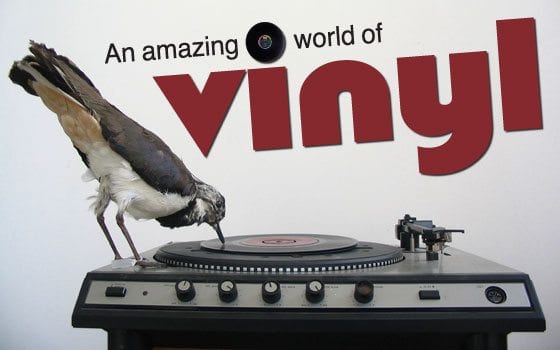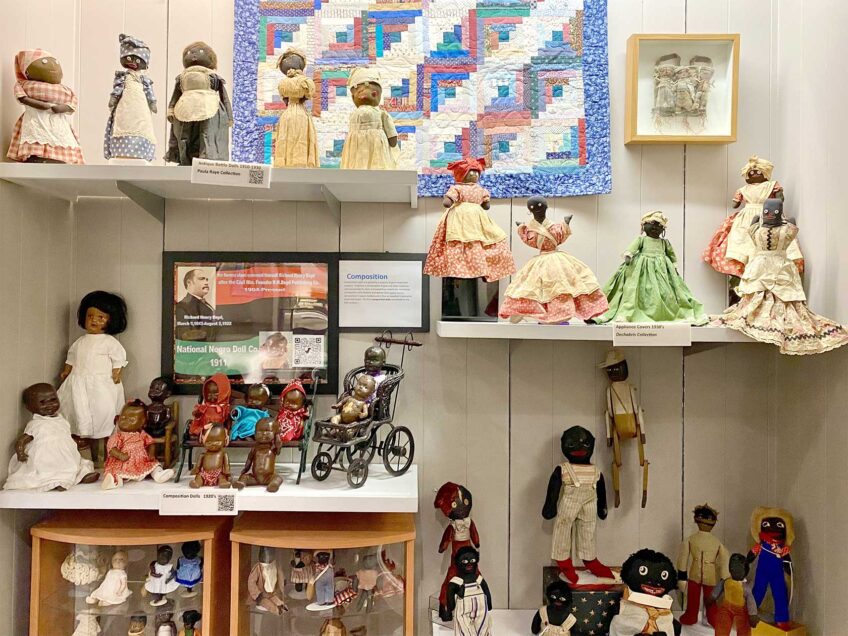

Jeroen Diepenmaat, Pour des dents d’un blanc éclatant et saines, 2005. Record players, vinyl records, taxidermied birds and sound. Dimensions variable. © Jeroen Diepenmaat. Image courtesy of the artist.

Jeroen Diepenmaat, Pour des dents d’un blanc éclatant et saines, 2005. Record players, vinyl records, taxidermied birds and sound. Dimensions variable. © Jeroen Diepenmaat. Image courtesy of the artist.

Jeroen Diepenmaat, Pour des dents d’un blanc éclatant et saines, 2005. Record players, vinyl records, taxidermied birds and sound. Dimensions variable. © Jeroen Diepenmaat. Image courtesy of the artist.
A new exhibit at ICA highlights the creative art of vinyl records
The primal forms of the circle and square in a vinyl record and an album cover draw artists like catnip, along with the music on the record and its world of memories and emotions, associations that artists can harness like so many ready-mades.
Unlike CDs and MP players, records have heft and presence. Even the covers of many albums are works of art, suggesting the transformative power of the music that ignites when needle strikes groove.
My own collection of albums is small but choice — and each is a landmark of a time in my life. Among my strongest childhood memories are my first records, turquoise 45-r.p.m. recordings of “The Teddy Bear’s Picnic” and “I Wonder As I Wander” that I ceaselessly played on my small turntable — a wonder box.
The absorbing exhibition, “The Record: Contemporary Art and Vinyl,” on view through Sept. 5 at the Institute of Contemporary Art/Boston, is a chamber of wonders. Like the 16th century European precursor of the art museum known as a wonder room, it is a mix of oddities and some first-rate art, an immersion into the vinyl record world that blends artistic complexity with the amateur’s obsessive love of objects.
How else do you describe an exhibition in which a stuffed bird stands in for a turntable tone arm and a display shows circular buttons made from melted Billie Holiday records?
Organized by Trevor Schoonmaker, curator of Contemporary Art at the Nasher Museum of Art at Duke University, where the exhibition originated, and coordinated for the ICA by Senior Curator Jenelle Porter, “The Record” is the first museum exhibition to bring together contemporary works with records as their subject or medium.
Presenting 99 works from the 1960s to the present — including sculpture, installation, drawing, photography and video — by 33 artists from around the world, the exhibition is accompanied by a terrific catalog that includes the artists’ own commentaries as well as an audio guide and website (www.nasher.duke.edu/therecord/index.php).
Loosely arranged around themes in four galleries, the exhibition mingles small images by big-name artists who came of age in the 1960s such as Jaspar Johns and Ed Ruscha with installations by much younger artists who first experienced records after their eclipse into artifacts. The strongest works explore the incantatory power of records to reincarnate the past into the present and future.
Few artists are as ardent at reclaiming life from spent materials than Dario Robleto of San Antonio, whose luminous tributes to record albums and Civil War widows were the high points of the group show “The Old Weird America,’’ at the deCordova Sculpture Park and Museum in 2009.
Here, a vitrine displays the buttons Robleto crafted from hand-ground records of Billie Holiday, sewed onto thrift-store shirts that he repaired and returned to their place of origin; matches he coated with the powder from records of Patsy Cline, Hank Williams and others and left on bars to enflame the cigarettes of courting couples; and a spool of thread from a record of Patsy Cline’s “I Fall to Pieces.”
Nearby in cool contrast is another small work that exudes power, Christian Marclay’s glistening metallic sculpture, “Secret” (1988). A brass lock instead of a tone arm crosses the grooves of a silver-plated 45-r.p.m. record, as if to silence sound.
Commanding the gallery like a stage set is Satch Hoyt’s “Celestial Vessel” (2009). Suspended from the ceiling, the life-size canoe is composed of red 45-r.p.m. records. Hoyt accompanies with a sound track of 17 musical passages that vary from a Franz Listz symphony and recordings of tribes in the Belgian Congo to excerpts from LPs by the Count Basie Orchestra and the Art Ensemble of Chicago. The installation evokes the barge that bears the Egyptian sun god, Ra, in his daily circumnavigation of the cosmos and the passage of slaves from Africa to America.
Its equally imposing neighbor is Peruvian William Cordova’s 19’ tall totem, entitled, “Greatest Hits (para Micaela Bastidas, Tom Wilson y Anna Mae Aquash)” (2008). The tower of 3,000 LPs is a monument to three overlooked heroes: Bastidas, an 18th century martyr for Peruvian independence; Wilson, an African American music producer and Harvard graduate who during the 1960s helped launch the careers of Bob Dylan, the Velvet Underground and others; and Aquash, an American Indian Movement activist slain in 1975.
In the second gallery, album covers conjure social, cultural and personal stories. Brimming with verve, Malick Sidibé’s spectacular quartet of gelatin silver prints, photographed from 1967 through 1973, show young people in Mali in exuberant poses with their records and turntables.
A grid of photographs by Felipe Barbosa of Rio de Janeiro, “Autographs” (2008-09), evokes the stars of Tropicália, Brazil’s liberating, African American inflected pop music that rose up the 1960s. His images show the covers of record albums signed by their owners.
Framed by paper flowers, Dario Robleto’s meticulously constructed collage of fictional album covers satirizes religious fundamentalism and other American excesses.
Equally well crafted is Peruvian Alice Wagner’s “Serie Percusión” (2009). Recreating in fabric and thread five Modernist album covers designed by artists, her hand-made collages celebrate the joy of graphics as well as jazz.
Another spare, geometric riff on album covers is the pair of handsome, large-scale prints by Dave Muller. The spines of the albums create an image of long, primary color lines but the titles are also visible, conveying the musical tastes of his family.
Album covers become autobiography in the hands of outsider artist “Mingering Mike” of Washington, D.C. As a teenager in 1968, he began a decade-long fantasy career as soul superstar and producer by creating more than 50 cartoon-like album covers. Occupying two large vitrines, they humorously celebrate Motown and RandB and work in real life too, starting in 1970, when be became a draftee.
Carrie Mae Weems, renowned for stirring works that explore the complexities of race in America, pairs a gold record for civil rights with an imaginary album in “Ode to Affirmative Action” (1989). Photographed on the album cover, Weems casts herself as Dee Dee, a 1960s RandB singer. The album title, “Live at The Copa” refers to the famed New York club that once banned black patrons and performers; and her invented record label, Clarksdale Records, is a nod to the Mississippi hometown of many legendary blues singers.
The apparatus of recording and playing LPs is explored in the third gallery, which showcases musician Laurie Anderson’s iconic “Viophonograph” (1977), her hybrid of a violin and record player.
David McConnell’s diverting “Phonosymphonic Sun” (2008-09) arranges six vintage record players in a semi-circle like members of a chamber music ensemble. Reassembled to flaunt their uselessness, the turntables are propped up as lids on top of the speakers. Each unit generates a distinct sound track that blends with the others into an infectious whole.
Jeroen Diepenmaat’s installation places stuffed birds on turntables, their beaks functioning as needles. West African raffia mats used for cooking swirl in place of records on the turntables of Fatimah Tuggar’s “Fai-fain Gramophone” (2010). Born in Nigeria, Tuggar pairs her entertainment center with the recordings of Barmani Choge, an all-female band that sings of female roles in the Hausa language and uses kitchen utensils as percussive instruments.
If I could take home one work in this show, it would be the witty three-by-three grid of black and white photographs by Cape Town-born Robin Rhode. Starting with a chalk drawing of a square and a spoon-like tone arm, the ensemble progresses like an animation storyboard to show the steps of setting a record in motion on a turntable — and in the process, creates a visual image of syncopation.
Mark Soo displays wall-sized 3-D images of the installation he built to replicate the storied Sun Studio in Memphis as it may have looked in 1954, when Elvis Presley recorded his first single, bluesman Arthur Crudup’s song, “That’s All Right, Mama.” Viewing the scene through the 3-D specs, I had the tantalizing illusion of almost stepping inside the past, a longing that Seattle-based art critic Jen Graves notes in her essay about the work, writing, “The image makes you ache.”
In the show’s fourth gallery, some works contemplate the mysteries, curiosities and rituals associated with experiencing music through record albums. Su-Mei Tse’s pristine installation “White Noise” (2009) tops a veneer cube of a turntable with a record pocked with tiny white bubbles — a tribute to dust specks.
An evocative trio of photographs by Moyra Davey includes a portrait of fast-obsolescing treasures — books and record albums, and an impressionistic close-up of a cartridge touching an LP. The record’s blurry specks of dust suggest the orbs of lantern light in a Toulouse-Lautrec painting of a Parisian dance hall.
Taiyo Kimura of Japan displays a swarm of small, ink-drawn cartoons that, alongside his five-minute video of Dadaist pranks with LP paraphernalia offers an irresistible sampling of his surreal humor. In his drawings, he plays with the black circle of a record as so much visual silly putty (in one drawing, a centipede is a tone arm).
Reveries too are on display in the arresting landscape photographs by Xaviera Simmons. In its own room, her installation “Thundersnow Road, North Carolina” (2010) features six scenes from her travels across North Carolina, each accompanied by an original soundtrack.
In the ICA’s media center is the installation “Cover to Cover,” where you can browse albums and sample music. Each of its seven turntables is equipped with a crate of 20 albums curated by a guest artist.
Admission to the ICA is always free to youth up to age 17 and free to all on Thursdays from 5 p.m. to 9 p.m.


![Banner [Virtual] Art Gallery](https://baystatebanner.com/wp-content/uploads/2024/04/Cagen-Luse_Men-at-store-e1713991226112-150x150.jpg)

![Banner [Virtual] Art Gallery](https://baystatebanner.com/wp-content/uploads/2024/04/Cagen-Luse_Men-at-store-e1713991226112-848x569.jpg)

